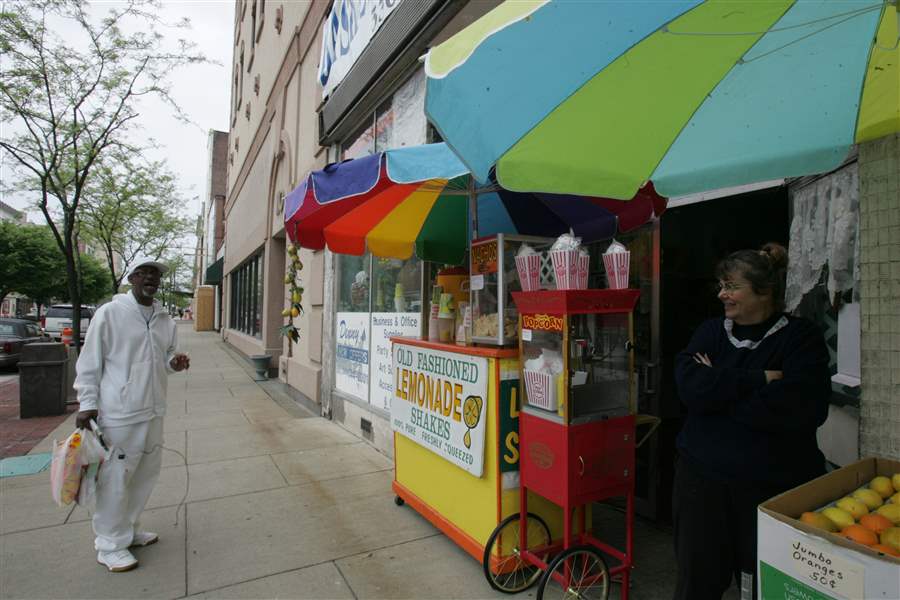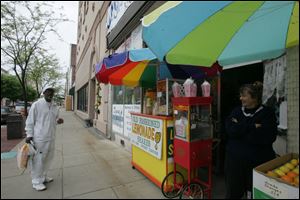
DOWN BUT NOT OUT
Once a lemon, Youngstown's working on a better lemonade
6/25/2008
Karen Arranz, right, chats with a customer at her lemonade stand in downtown Youngstown. Her sales, like the city, are going through tough times but will survive and thrive, she predicts
The Blade/Lori King
Buy This Image

Karen Arranz, right, chats with a customer at her lemonade stand in downtown Youngstown. Her sales, like the city, are going through tough times but will survive and thrive, she predicts
YOUNGSTOWN -- Karen Arranz spends her days turning lemons into lemonade.
The lemonade cart she tends on West Federal Street in downtown Youngstown is surrounded by vacant storefronts, obsolete office towers, and roadway construction.
But the Youngstown woman sees only progress.
"Youngstown has always been a comeback place, and it will come back again," said Ms. Arranz as she pointed out nightclubs that have replaced abandoned retail sites, vacant office towers that developers promise to fill with apartments, and road work that will improve traffic flow and increase parking.
Youngstown has grabbed international headlines in recent years for a controversial program to "right-size" the city by razing hundreds of abandoned homes, stores, and schools to match a municipal population that has declined by half to 82,000 since the mid-1960s.
But another, lower-profile, restoration effort has been taking place in the city core.
READ MORE: Down But Not Out series
More than $100 million - most of it federal and state dollars - has been pumped into downtown to create Chevrolet Centre arena, two new federal courthouses, a state office building, a pair of side-by-side business incubators, a state appeals court building, and the DeYor performing arts center.
Yet, along downtown's main thoroughfare, vacant storefronts abound. "For sale by owner" reads a sign affixed to gray corrugated metal covering a shop front.
On other vacant shops, enlarged photos of the Mahoning Valley city in its heyday - like ghostly apparitions - reveal a prewar era when streets were crowded with people and cars. A photo of a long-gone theater marquee shows that Her First Romance, starring Edith Fellows and Wilbur Evans, was playing the day the image was captured.
Today, Youngstown is among the poorest midsized cities in America, with a median household income of $21,850 in 2006, according to U.S. Census data released last summer. It is Ohio's seventh-largest metro area, behind Toledo, with 571,000 residents.
Restaurateur Tom Simon remembers a time when big department stores like Higbee's and Kaufmann's drew crowds to downtown shops and eateries. "It was just packed," he recalled, his voice dripping with nostalgia.
But the city's marquee industry, steel, began to melt away.
Events culminated Sept. 19, 1977 - a day remembered here as Black Monday - in the closing of a large portion of Youngstown Sheet & Tube.
The event so traumatized this Mahoning County community that the nearby Historical Center of Industry & Labor devotes an entire exhibit to Black Monday. News footage from that day plays continuously.
The events devastated the downtown area. "About five years later, everything was gone," recalled Mr. Simon, standing behind the 100-year-old bar of his Cedar's Bar & Dining.
Things are better now, he said. Concerts and minor-league hockey games at "Chevy" Centre and events at other downtown venues help to fill nearby restaurants. Those businesses also have been boosted by growth at nearby Youngstown State University, with more than 13,000 students, a short walk away.
"It's like a renaissance," Mr. Simon said.
One downtown merchant estimates there are about 50 businesses, mostly small convenience stores and restaurants.
Keith Mann, a former teacher in Sylvania City Schools who now is an education specialist at the Youngstown Historical Center, is impressed with the public-sector projects that are remaking downtown. "I see some optimistic signs things will get better," he said.
"You have to have seen downtown 10 years ago," added Jay Williams, Youngstown's mayor and architect of the controversial plan to "right-size" the city.
"Over the past three years, restaurants and night clubs have opened," he said.
The 5,700-seat Chevrolet Centre, built in 2005 with a $25 million grant from the U.S. Department of Housing and Urban Development, is host to 150 events a year, including games of the Youngstown SteelHounds hockey team, he noted.

Cultural events are held at Powers Auditorium, which is part of the DeYor Center.
The current national economic slump - which is making it difficult for officials to balance the city budget - has complicated redevelopment efforts, the mayor acknowledged.
"It has been an uphill struggle and will continue to be," he said.
Yet Mr. Williams predicted that vacant storefronts will begin to fill as promised new downtown housing materializes.
Cleveland parking lot executive Lou Frangos is converting the 13-story Realty Towers into 23 apartments aimed at young professionals. Nearly half of the cost of the $8 million project will be covered by state and federal tax credits. Work began in mid-May and is to be completed in a year, he said.
He also received tax credits for converting two other historic office towers to 70 additional apartments: the 11-story Wick Building and the three-story Erie Terminal. He hopes to begin work this year, although financing isn't completed for those projects, Mr. Frangos acknowledged.
He owns three other downtown office towers and is bullish on the downtown market. "With no apartments available, we know we're going to be able to lease the first building quickly," he said. "And then we'll move on to the next one."
But he conceded that occupancy at the Chase Building, which his Frangos Group is retaining as an office tower, is only about 50 percent.
Art Lewis, a real estate agent who specializes in commercial property, is not aware of an available office-vacancy report for Youngstown. He estimated that about 5 percent of newer space downtown is empty, compared with 15 percent for older buildings.
Like other major-city downtowns across Ohio, Youngstown lost businesses and workers in the first half of the decade.
The city's main downtown ZIP code had 219 firms with 3,616 private-sector employees in 2005, according to the most recent U.S. Census figures. That represents a loss of 17 percent of businesses and 31 percent of workers since 2000, according to the Census Bureau. The estimates don't include public employees.
It is unclear how many people government agencies employ downtown. But the U.S. Labor Department reports that the 239,000-person work force of metro Youngstown includes 32,000 government workers.
Tom Humphries, the president of the Youngstown-Warren Chamber predicted that new reports, when released, will show job growth downtown. Banks, call centers, and law firms have added employees in the city core, he said.
And officials of the nonprofit Youngstown Business Incubator, along Federal Street, are convinced that they have a strategy for boosting downtown employment further: Provide a supportive and nurturing environment for firms involved in computer software development and use.
Already, one firm that started there, Turning Technologies LLC, has grown to $21 million in sales annually and 130 employees.
The firm, which produces proprietary software that allows audience members to use cards and hand-held devices to instantly respond individually to questions and polls from moderators, is among the fastest-growing small businesses in America, according to Inc. magazine.
Nearby, along Federal Street, the early '60s love song "Blue Velvet" hums from a radio Ms. Arranz has set up near her lemonade cart to add a zest to an otherwise dreary day.
"We're hardy people," she said of Youngstown residents. Like many people here, she takes pride in the city's somewhat checkered past. "We were known as mob town U.S.A.," she said. "We still have elements of that."
Lemonade sales were slow this day, she conceded. "We sold about 25 glasses. But it's cold. On a hotter day, we'd sell 100 to 125 glasses."
Contact Gary Pakulski at: gpakulski@theblade.com or 419-724-6082.